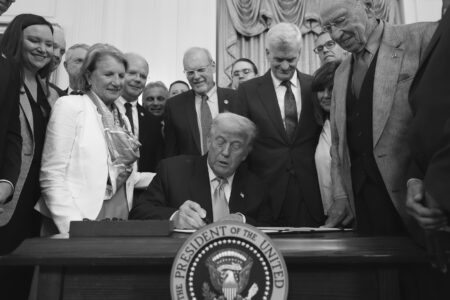When waste-cutters miss what looks like, umm, waste
Andy McKean is a charming country lawyer from Anamosa. He grew up in New York and was drawn to Iowa by his family roots.
He has owned a bed-and-breakfast, called square dances and played in a dance band named the Scotch Grove Pioneers. His tenure in the Iowa Legislature stretched for nearly 30 years, with an additional eight years shoehorned in as a Jones County supervisor.
A few weeks ago, McKean spoke to a group of grassroots community organizers from eastern Iowa who gathered in Monticello to brainstorm. He provided pointers gleaned from his years in public service, politics, campaigning, promising and compromising.
One choice nugget was his go-to strategy in those roles — listening more than talking.
A lot of Iowans were laser-focused on campaign talking points during the run-up to the recent passage of what the president and Republicans called One Big Beautiful Bill. Taking a lesson from McKean, I spent more time listening to what our leaders and would-be leaders said about the legislation and its contents.
The central message from Republicans explaining their position, aside from a desire to keep tax cuts in place, is eliminating wasteful or unnecessary government spending. We can debate later how the income tax cuts were allocated. But most people agree spending must be restrained because we cannot allow the federal debt to grow at its current rate.
I have heard some excellent questions from ordinary Iowans based on that conclusion. For example:
(1) Why did Congress provide $40 million in the One Big Beautiful Bill to construct a National Garden of American Heroes, with the site mentioned most often being the Black Hills of South Dakota, where there already is one big beautiful monument called Mount Rushmore?
(2) Who thinks it is a good idea to earmark $85 million to move the space shuttle Discovery from the Smithsonian’s aviation center in suburban Washington, D.C., to a new site and new building in Houston, Texas?
(3) Although not part of the Big Beautiful Bill, why did members of Congress stay silent when the Pentagon diverted about $400 million from this year’s nuclear missile modernization program to start retrofitting the luxury jetliner Qatar gave the United States to serve as President Trump’s temporary Air Force One while Boeing completes a new set of presidential jets?
In past years, building a new national monument, relocating a piece of space hardware or sinking nearly a half-billion dollars on a temporary acquisition would raise eyebrows in Congress. A spending critic named Chuck Grassley even posted a video seven years ago patting himself on the back for a long record of keeping government spending in check.
He recalled his 1968 efforts to curb military spending this way: “To get the camel’s nose under the tent, the big spenders at the Pentagon essentially fit ten pounds of manure in a five-pound sack. This senator wasn’t going to buy that. Not when taxpayers were getting soaked for wasteful spending on weapons systems and spare parts. The $7,000 coffee pot I remember and the $750 price tag on pliers didn’t fly with this penny-pinching Iowan and all Iowans together.”
These days, nonessential spending seems at odds with the efficiency and cost-cutting messaging from the president and Republican majority in Congress.
Supporters who pushed for $85 million to haul the space shuttle to Texas used a legislative strategy in a bill to *reduce* government spending. That tactic is one longtime members of Congress know well — getting even a modest amount in an appropriations bill to start some project when they know the ultimate cost will be much higher.
The Smithsonian estimates the true cost of getting the Discovery to Houston will far exceed $85 million, perhaps reaching $300 million once all costs for the move and to construct a new building for it are tallied.
The National Garden of American Heroes faces a variety of challenges, with cost being one. The president wants the government to create 250 life-sized, outdoor statues of people he describes as historical figures. Reaching consensus on who makes the list of 250 and who is left off is a recipe for national indigestion.
Beyond the “who,” the “where” such a monument garden would be constructed has the potential for ulcers, too. The South Dakota Searchlight, an online news site, said that state’s governor offered the president land about a mile east of Mount Rushmore that borders the Black Hills National Forest.
The Searchlight said some Black Hills residents are conflicted about the proposed monument garden.
“They know tourism is vital to their economy,” the Searchlight wrote. “They also know that if the Black Hills is overpromoted and overdeveloped in pursuit of tourist dollars, it’ll wreck some of the natural beauty that inspires tourists to visit in the first place.”
The article said: “If the Black Hills location is chosen, a peaceful pocket of nature will be obliterated to make way for a new road, a parking lot and statues of Kobe Bryant, Julia Child, Whitney Houston, Vince Lombardi and Alex Trebek.”
Yes, they are on the list of honorees, along with such other “heroes” as Annie Oakley, Cy Young, Alfred Hitchcock and Lauren Bacall.
Keeping with the spirit of One Big Beautiful Bill, instead of setting out a bunch of statues near Mount Rushmore, why not save money and create a virtual hall of heroes? Even better, why not have the government simply encourage people to stop at their local public library, check out a book or two, and satisfy their hunger for hero information that way?
That is what I have heard on my listen-like-Andy-McKean interaction with Iowans.
——–
Randy Evans is the executive director of the
Iowa Freedom of Information Council. He can be reached
at DMRevans2810@gmail.com.



